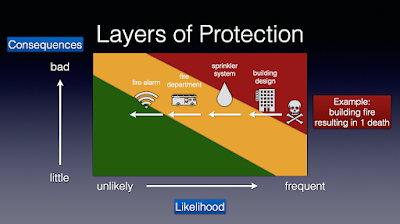 |
| Click to enlarge. |
Things happen.
"Risk" is a combination of "Consequences" and "Likelihood."
If a hazard is of little consequence and unlikely, people tend to judge the risk as broadly acceptable (green).If a hazard can lead to bad consequences but is unlikely, people may view the risk as acceptable (yellow).
If something is frequent but not much of a problem, people might put up with it (yellow).
The really bad situations are those where the consequences are bad and they happen frequently or are certain to happen. Most people would agree those are risks that should be avoided (red).
The chart, above, is a generic risk matrix. They are used to analyze risk.
For example, this is how risk from a building fire might be analyzed...
In this example, if the worst thing to happen in a particular building fire is one death, it might be shown like this in the scale of consequences, something to definitely avoid.
If the worst thing to happen in the fire is someone goes to the hospital with smoke inhalation, it would probably be judged to be acceptable because they would be treated and recover. There would be no lasting harm.
If there were multiple fatalities, that would be worse and certainly something to avoid.
How do we reduce the risk of bad consequences from a building fire? We introduce "layers of protection" to reduce the likelihood of it happening.
The consequence would still be someone dying, but we add enough independent protections to push the situation into the green.
Architects, engineers, and fire prevention experts have learned how to construct buildings so they are less susceptible to fire. They use steel, concrete, and drywall because those things do not burn. That reduces the risk of fire in the first place.
Installing a sprinkler system to control and possibly extinguish a fire is a separate layer of protection.
A trained and experienced fire department with modern, reliable equipment that can quickly respond is another layer of protection.
And finally, a fire alarm system can warn people so they can evacuate the building.
All of these things combine to reduce the risk of somebody dying in a building fire. People living in society take these things for granted and are perfectly comfortable being in modern buildings. They see the risk as broadly acceptable.
In this accident, it appears nobody was hurt, but if there had been a passenger in the front seat the situation would have been tragic.
The guardrail was there as a layer of protection to prevent someone from traveling off the road, but in this case it proved to be a hazard itself.
Automobile design, highway design, and guardrail design all influenced the outcome.
Operator training, experience, and operating conventions such as speed limits were also relevant.
Whoever was in control of this conveyance (pickup truck) probably fell asleep. The "rumble strips" along the edge of the road were a layer of protection, but did not prevent the accident in this case.
A proximity alarm may be available in some newer, high-end pickup trucks, but was probably not a feature in this older model.
Seat belts and airbags are definitely layers of protection, but they would not have helped in this case.
Race car drivers utilize more layers of protection because the likelihood of them being in a crash is greater. They wear helmets, gloves, fire resistant or fireproof clothing, and have much more substantial restraint gear to keep them relatively safe.
American Government has layers of protection. Some of them are specifically stipulated in Amendments to the Constitutions with the subcontractors...
- Freedom of speech.
- Freedom of the press.
- The right to peaceably assemble.
- The right to petition the Government for a redress of grievances.
- The right to keep and bear arms.
- Etc.
Robust debate is another protection.
Public meetings are a protection.
Public records are a protection.
These things all reduce the risk of despotism.











No comments:
Post a Comment